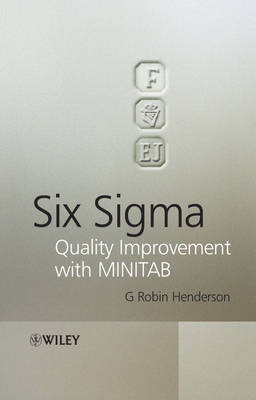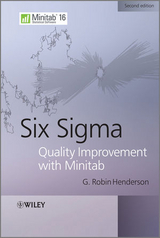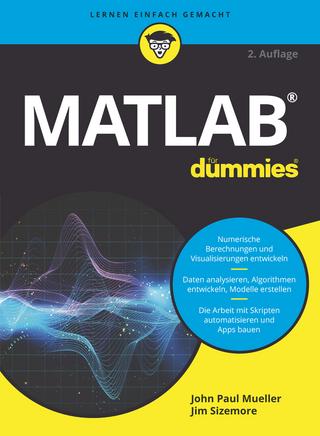
Six Sigma
Wiley-Blackwell (Verlag)
978-0-470-01155-3 (ISBN)
- Titel erscheint in neuer Auflage
- Artikel merken
Quality Improvement should be something everyone strives to achieve in the workplace, whether in manufacturing, services or healthcare. There are numerous strategies for Quality Improvement, but none to rival Six Sigma, both in terms of growing popularity, and the emphasis that it places on the use of statistical methods. "Six Sigma Quality Improvement with MINITAB" explains the most important statistical methods employed in Six Sigma and demonstrates their implementation via the very popular, and user-friendly, statistical software package MINITAB (Release 14).
The features include: introduction to key statistical methods for Quality Improvement using MINITAB; minimal prior knowledge of statistical methods and no prior knowledge of MINITAB assumed; easy-to-follow guidance for Six Sigma Green and Black Belts and others involved in Quality Improvement; provides informative follow-up exercises, from a wide variety of scenarios, on each topic; employs random data generation in MINITAB to aid understanding of key statistical concepts; supported by a website featuring data sets for download and notes and answers for the follow-up exercises; and developed from the author's wealth of experience gained from many years working both in education and consultancy. This book will be of great value to Six Sigma practitioners, as well as those employing other strategies for Quality Improvement. Furthermore, students of Quality Improvement and anyone with an interest in data analysis and statistical methods and their implementation via MINITAB software will find this book invaluable.
Robin Henderson studied Mathematics in Professor Alexander Aitken's department at the University of Edinburgh. Professor Aitken developed the matrix formulation of linear regression models that is employed in statistical software packages such as MINITAB1. Following graduation, the author trained as a secondary school teacher and began his career in education at Boroughmuir School, Edinburgh. Since 2001, Robin has been operating as a sole consultant, trading as Halcro Consultancy, Loanhead, providing training and consultancy in statistics for quality improvement and Six Sigma. He has assisted Colin Barr Associates with the training of three groups of Six Sigma Black Belts, some participants being from nonmanufacturing organizations. With the Scottish Advanced Manufacturing Centre he has provided training and consultancy in statistical methods for quality improvement to two major companies. He is also currently employed as Coordinator at the Royal Infirmary of Edinburgh for the Scottish National Stroke Audit. On this project he has introduced the use of Shewhart control charts for monitoring aspects of the process of stroke care. Membership of the Committee of the Quality Improvement Section of the Royal Statistical Society, of which he is a Fellow, is a role that the author finds stimulating and enjoyable. He is also a member of ENBIS, the European Network for Business and Industrial Statistics.
Foreword. Preface. About the author. 1 Introduction. 1.1 Quality and quality improvement. 1.2 Six Sigma quality improvement. 1.3 The Six Sigma roadmap and DMAIC. 1.4 The role of statistical methods in Six Sigma. 1.5 MINITAB and its role in the implementation of statistical methods. 1.6 Exercises and follow-up activities. 2 Introduction to MINITAB, data display, summary and manipulation. 2.1 The run chart - a first MINITAB session. 2.2 Display and summary of univariate data. 2.3 Data input, output, manipulation and management. 2.4 Exercises and follow-up activities. 3 Exploratory data analysis, display and summary of multivariate data. 3.1 Exploratory data analysis. 3.2 Display and summary of bivariate and multivariate data. 3.3 Exercises and follow-up activities. 4 Statistical models. 4.1 Fundamentals of probability. 4.2 Probability distributions for counts and measurements. 4.3 Distribution of means and proportions. 4.4 Exercises and follow-up activities. 5 Control charts. 5.1 Shewhart charts for measurement data. 5.2 Shewhart charts for attribute data. 5.3 Process adjustment. 5.4 Exercises and follow-up activities. 6 Process capability analysis. 6.1 Process capability. 6.2 Exercises and follow-up activities. 7 Process experimentation with a single factor. 7.1 Fundamental concepts in hypothesis testing. 7.2 Tests and confidence intervals for the comparison of means and of proportions with a standard. 7.3 Tests and confidence intervals for the comparison of two means or two proportions. 7.4 The analysis of paired data - t-tests and sign tests. 7.5 Experiments with a single factor having more than two levels. 7.6 Blocking in single-factor experiments. 7.7 Experiments with a single factor, with more than two levels, where the response is a proportion. 7.8 Tests for equality of variance. 7.9 Exercises and follow-up activities. 8 Process experimentation with two or more factors. 8.1 General factorial experiments. 8.2 Full factorial experiments in the 2k series. 8.3 Fractional factorial experiments in the 2k-p series. 8.4 Exercises and follow-up activities. 9 Evaluation of measurement processes. 9.1 Measurement process concepts. 9.2 Gauge repeatability and reproducibility (R&R) studies. 9.3 Attribute scenarios. 9.4 Exercises and follow-up activities. 10 Regression and model building. 10.1 Regression with a single predictor variable. 10.2 Multiple regression. 10.3 Response surface methods. 10.4 Exercises and follow-up activities. 11 More about MINITAB. 11.1 Learning more about MINITAB and obtaining help. 11.2 Macros. 11.3 Further MINITAB. 11.4 Postscript. Appendices. References. Index.
| Zusatzinfo | illustrations |
|---|---|
| Verlagsort | Hoboken |
| Sprache | englisch |
| Maße | 180 x 249 mm |
| Gewicht | 998 g |
| Einbandart | gebunden |
| Themenwelt | Mathematik / Informatik ► Mathematik ► Wahrscheinlichkeit / Kombinatorik |
| Wirtschaft ► Betriebswirtschaft / Management ► Logistik / Produktion | |
| ISBN-10 | 0-470-01155-6 / 0470011556 |
| ISBN-13 | 978-0-470-01155-3 / 9780470011553 |
| Zustand | Neuware |
| Informationen gemäß Produktsicherheitsverordnung (GPSR) | |
| Haben Sie eine Frage zum Produkt? |
aus dem Bereich



